#chalk fish fossil
Explore tagged Tumblr posts
Photo

Fossil Chalk Fish Scales (Osteichthyes) | Grey Chalk Cretaceous Clyde Sussex UK | Genuine Specimen with COA
Own a rare and scientifically valuable specimen of fossil fish scales (Osteichthyes) from the Grey Chalk Formation of the Cretaceous period, collected in Clyde, Sussex, UK. These scales represent part of the bony fish group (Osteichthyes), a major vertebrate lineage that dominated Mesozoic marine environments.
Fossil Type: Fish Scales (Osteichthyes – Bony Fish)
Geological Period: Late Cretaceous (~100.5 to 89.8 million years ago)
Formation: Grey Chalk Formation
Location: Clyde, Sussex, United Kingdom
Scale Rule: Squares/Cube = 1cm (Please refer to the photo for full sizing)
Specimen: The actual specimen in the listing photo is the one you will receive
Authenticity: All of our fossils are 100% genuine specimens and come with a Certificate of Authenticity
Geological and Paleontological Context
These fossil fish scales belonged to Osteichthyes, or bony fish, a major group of marine vertebrates that thrived in the Cretaceous seas. The Grey Chalk is known for preserving delicate microfossils, vertebrate remains, and marine invertebrates from shallow, warm seas rich in calcium carbonate sediments.
Phylum: Chordata
Class: Actinopterygii (ray-finned bony fishes)
Geological Stage: Most likely Cenomanian stage (~100.5–93.9 Ma), based on regional stratigraphy of the Grey Chalk
Depositional Environment: Calm, shallow marine shelf with low-energy sedimentation; fossilisation occurred within fine calcareous sediments of the chalk sea
Morphological Features: Small, shiny or mineralised scales often showing fine ridges, growth rings, or peg-and-socket articulation patterns typical of actinopterygian fishes
Notable: Fossil fish remains in the Grey Chalk are rare compared to invertebrate fossils, making vertebrate microfossils like these valuable for collectors and paleontologists
Biozone: May be associated with the Lower to Middle Cenomanian ammonite or inoceramid zones (e.g., Mantelliceras or Inoceramus zones)
Identifier: Osteichthyan microremains have been recorded in UK chalk studies since the 19th century; formal identification to genus level often requires microscopic examination
Why This Fossil is Special
Fossil fish scales like these are a window into the vertebrate life of the Cretaceous chalk seas—often overlooked yet scientifically important. These remains can be used to reconstruct fish diversity and ecology in ancient marine ecosystems.
Why Buy From Us?
100% genuine fossil with Certificate of Authenticity
The exact item shown is the one you’ll receive
Carefully sourced from reputable UK fossil sites
Excellent for microfossil collectors, educators, and vertebrate paleontology enthusiasts
Own a piece of ancient marine vertebrate history with this Osteichthyes fossil fish scale specimen from the Grey Chalk of Clyde, Sussex—a rare glimpse into bony fish evolution from over 90 million years ago.
#fossil fish scales#Osteichthyes fossil#chalk fish fossil#Cretaceous fish fossil#Grey Chalk fossil#Clyde Sussex fossil#UK fish fossil#bony fish fossil#fossil with certificate#certified fossil#genuine fossil#prehistoric fish scale#natural history fossil#microfossil#Cretaceous marine life#vertebrate fossil
0 notes
Note
Toons can eat non food stuff or stuff that isn't normally eaten by human,due to having extremely strong digestive systems,they have fav one too,they just doesn't allowed to eat those due to it could make children to learn and eat forbidden stuff
Rodger drink ink and eat paper sometimes
Teagan eat teabags frequently(this one is quite edible, but I mean the whole teabag and not just the leaves in it)
Gigi eats any object if she wants,she isn't picky, although she likes to eat repeated item she collected and shiny objects sometimes
Looey eat balloons and confetti
Dandy eat any non poisonous plants and plant fertilizer(I remembered seeing Dandy eat dirt HC before,so it adds on lol)
Pebbles eat rocks and even fossil if it weren't because Shelly stop him from it
Shelly has same diet s Pebble,but restrain herself from eating fossil since she don't wanna destroy those precious fossil(she eat bone to cope with the urge)
Vee eat whatever electronic stuff
Tisha drink cleaning products and eat her own tissues a few times
Poppy drink and eat soap N shampoo,has eat soda can a few times before
Brightney eat papers, batteries,wires and have urge to eat books sometimes (bookworm taken too literally)
Glisten eat & drink makeup a few times before, tried eating ribbons too
Boxten eat gear and sometimes drink gear oil
Finn eat fish food frequently
Flutter eat flowers and sometimes paper
Toodles eat those pool ball cue chalk
Coal has same diet as Pebbles,likes to eat literal coal,snow,ice and gift wrapper
Bobette eat gift wrapper very frequently
Rudie eat grass and plants ofc,but also eat gift wrappers beofre
Sprout,Ginger and Cosmo ate tin foil a few times before,but prefer edible food more
Astro eat glitter a lot
Goob and Scraps both eat craft item like glue,color pencil, paint and etc. Scraps eat paper more while Goob eat cotton more
Shrimpo is the only one who didn't eat object stuff,he is too angry to try anything else
(this is basically extension on Goob and Scrap eat object HC lol)
im just like rodger fr ( ate paper a few times, its not that bad.)
49 notes
·
View notes
Text
How I'd imagine the other characters 'cope' (<- Is this the word?) THIS IS NOT ALL OF THEM EITHER. STILL ESTABLISHING Doodle - They craft delicate origami flowers, slowly building their own little garden in the corner of the art studio. When not folding petals, they might shape tiny stars from paper scraps or carve miniature birds from blocks of wood, their hands always busy crafting something soft, small, and beautiful. A stark contrast to the pressure-filled demands of their fashion lines
Tempus - He likes to stroll along the jagged edge of the coast, where the sea meets stone, often pausing to sit and quietly watch the waves break over the rocks and lap at his feet. He’s also been known to gather seashells and scoop up loose fish scales scattered across the sand believing each of them tell a story of the forgotten
Belavia - They retreat into a world of fashion (particularly Lolita) hosting whimsical tea ceremonies amid their cherished vintage porcelain dolls. They’re found indulging in sweets, their face adorned with carefully applied makeup as they hum soft melodies
Cortex - His fascination with the past, especially dinosaurs and fossils, often leads him to dig eagerly in the dirt, treating history books like treasure maps guiding his adventures. They’ve always had a keen eye for geodes and crystals, incorporating shards of them into his inventions as a unique signature.. like a personal watermark
The Healthy Band - During their breaks from touring, the band usually escapes into nature exploring hiking trails, setting up camp in remote spots, and spending time meditating, fully surrendering to the calm and stillness of the outdoors
Lucid - She’s deeply obsessed with stars and planets, spending countless nights outside, lying beneath the sky and studying every detail. He takes careful notes and sketches constellations and planetary positions, mapping the heavens exactly as they appear
Wyrinth - He turns to photography as a way to seize moments that catch his eye. With Polaroid filters in hand, he carefully studies the interplay of light and shadow, freezing subtle details that others might overlook creating tiny, tangible memories out of the everyday.
Cadaverous - She’s a devoted horror fan, collecting everything from old VHS tapes to vintage thrifted t-shirts. He hunts for rare figurines and posters all find a place in her growing stash. His passion turns every find into a piece of her personal shrine to the macabre
Elvonix - They have a strong passion for attending underground raves and actively engaging in graffiti + street art culture. She truly comes alive when fully embracing the punk persona losing themselves in the role and owning the look down to every detail.
Lottie & Teddie - The twins love hanging out at the playground, sketching chalk art on the sidewalks, chasing bubbles that float through the air, and gathering dandelions while weaving imaginative stories on the swings! Each time the twins visit, they invent a brand-new play to perform and sometimes they’re lucky enough to be joined by a curious bunny that often hops close by
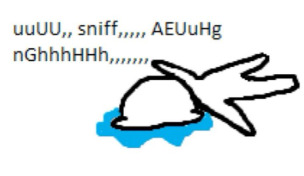
11 notes
·
View notes
Text
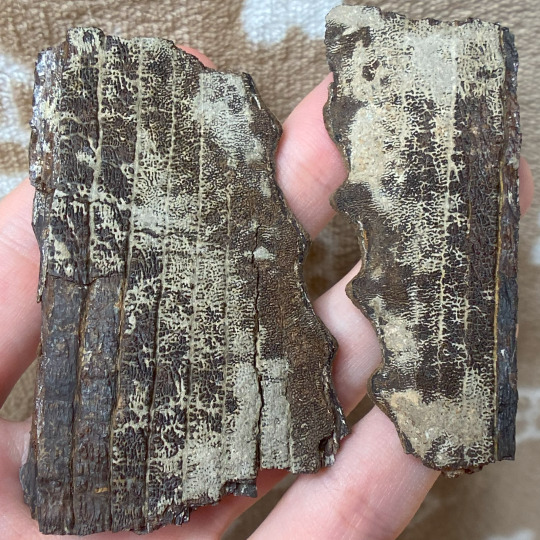
Partial pair of fossilized fish fin bones of a Protosphyraena sp. from the Niobrara Chalk in Kansas, United States. The pectoral fins of this Cretaceous aged fish are distinct and easily recognizable. These basal relatives of teleost fish convergently resemble swordfish or marlin having a pointed bill.
#fish#fossils#paleontology#palaeontology#paleo#palaeo#protosphyraena#pachycormidae#cretaceous#mesozoic#prehistoric#science#paleoblr#プロトスフィラエナ#��キコルムス科#化石#古生物学
12 notes
·
View notes
Text
The flights and their major exports
Ice: furs, fish, culinary or food grade ice, unique and seasonal herbs, spices and flora that only grow there in the spring, super rich culinary culture has formed here and it attracts tourism and foodies, cooking oils and fats, seeds and nuts for consumption
Nature: lumber, meats, spices, fertile soil, insect cuisine, perfumes, freshwater fish, houseplants, seeds and shoots for farming, decorative plant or wood working, plant based oils for cooking or fuel
Light: wheat, plant based fibers and fabrics, paper and or papyrus, chalk and marble, huge bread and baked goods industry, baskets, porcelain, exotic percivore cuisine, pigments, seasonal fruits
Earth: cactus fruits, minerals and stones, gemstones, terracotta creations or construction pieces, ceramic work, glass tile work, roots and tubers, fossils, pigments,
Wind: rice, grains, construction grade bamboo, paper, rice paper, fabrics, plants and small birds for consumption, instruments (specifically wood-wind), silks, ribbon, sonorous sculptures
Shadow: fungal harvests, wire craft, tactical suits and mantles to conceal the body, iron weaponry with decorative detailing, insect and plant exports, huge root farming industry, lantern exports, candles, woodturned tools/utensils/decor/etc
Water: shells and abalone, fish, seaweed and kelp cuisine, boats and boat blueprints, crustacean cuisine, huge huge huge provider for the pescatarians, opal
Lightning: machinery parts, batteries, cactus harvests, insulation for both heat and electricity, exotic insect cuisine, dried and aged foods, electricity is produced in excess enough to provide immediately to the surrounding territories
Arcane: stained glass, lumber from the starwood strand (has unique properties and could be used for construction or artistic works), magical batteries made from the crystals, tomes and books, lenses, exotic herbivore cuisine, luminous pigments, tapestry work
Plague: immunizers/immunizations, craft and construction grade bones, leather, ale/mead/wine/whiskey/etc because they have the most intricate and detailed brewing and fermenting processes due to the understanding they have surrounding bacteria, pickled foods and pickling kits, surgical grade tools, cheeses, dry aged meats, medical practices unlike any other
Fire: weapons and armor, exotic carnivore cuisine, glasswork and glass blowing, obsidian and basalt export, geothermic energy(they can provide power enough to the surrounding territories) intricate mosaic and tile work, mineral exports, ceramic exports, blackened foods, metal shells and armor for vessels and vehicles and mounts
These are just what I can think of by examining the map and element at face value, there are millions of things these places can produce and export but I think these are the big ones or what they are known for, maybe even just the best quality versions of the export! If you want to use these ideas or add your own feel free!
291 notes
·
View notes
Note
colorgenders inspired by the results of a “What is your Aura” quiz ((https://)uquiz(.)com/quiz/pxTx2D/what-color-is-your-aura):
Sky: short poems, teacups, clear skies, diaries, dripping icicles, tears, tennis shoes.
Honeysuckle: succulents, key lime, glow-in-the-dark stars, blown glass, honeydew, garter snakes, notes in bottles.
Seafoam: clear water, milkshakes, crystals, agave, candy dishes, converse, seashells.
Yellow: daisies, road signs, bumblebees, lemon meringue, bicycles, polaroids, awnings.
Hickory: felled oak, brass, sunken ships, olive pits, graphic shirts, splinters, dark room.
Orange: guitars, fanta bottles, sunglasses, orange peels, butterflies, popsicles, paper lanterns.
Sage: herb clippings, matcha, bullet journals, mini backpacks, needle felts, pistachio, laptop stickers.
Teal: dyed hair, scales, doc martens, aurora borealis, stormy seas, kingfishers, agate.
Royal (blue): crown jewels, portraits, satin chairs, masquerades, nebulas, betta fish, secrets.
Gold: lion statues, coins, gold leafing, bound books, goldfinches, crowns, heart lockets.
Crimson: rose vines, blood, apples, velvet, sharp nails, galaxies, dripping jewellery.
Navy: brush strokes, suit jackets, midnight, comforters, star gazing, arctic waters, starlings.
Forest: fern leaves, greenhouses, cloaks, bookstores, pine trees, chokers, snake scales.
honey: friendship bracelets, beehives, school buses, children's books, flower petals, honeyed toast, polaroids.
Ashen: old newspapers, smoke, quiet cities, pale cheeks, pebbles, chalk, the clouded moon.
Garnet: Brooches, anthologies, stained glass, leaves, dining chairs, long robes, curtains.
Chiffon: stone walls, sweaters, moths, dusty lace, animal tracks, incense, throw pillows.
Red: leather jackets, cherries, bruised knuckles, roses, lipstick, fast cars, rose petals.
Magenta: splattered paint, glitter, childhood friends, neon, pleather, dance floors, crystals.
Amaranth: bundled flowers, ribbon, merlot, overcoats, gemstones, lipstick prints, red velvet.
Periwinkle: knit hats, candies, tiny flowers, beads, teacups, washi tape, clouds.
Jade: islands, sketchbooks, rainy windows, pendants, puzzle pieces, tree frogs, sea glass.
Pink: cupcakes, sunglasses, pink sands, starbursts, pinky promises, flower crowns, ice cream.
Rose: lace, blown kisses, milk tea, paper fans, pillows, ballet slippers, fairy wings.
Amethyst: earrings, violet corts, parades, gemstones, insect wings, grape bushels, outer space.
Noir: drops of ink, eyeliner, crows, spiders, charcoal, painted nails, the night.
Cream: dandelions, marble, bottled coffee, hair ties, banana cream, bedsheets, sketches.
Beige: lattes, dry fields, footprints, easels, cat fur, pottery, fresh-baked cookies.
Pearl: abalone, perfume bottles, chandeliers, tulle, ball jointed dolls, satin, paint palettes.
Bronze: leather books, cowboy hats, foxes, candle jars, sword hilts, cobblestone streets, hourglasses
Amber: autumn days, freckles, torches, cabins, fossils, unbrushed hair, enamel pins.
Fire: sunrises, woven blankets, campfires, tigers, whiskey, monarchs, road trips.
Purple: geodes, club lights, ferris wheels, sunglasses, hummingbirds, eyeshadow, outer space.
Blush: lollipops, warm cheeks, lip gloss, flowers, flamingo feathers, painted nails, heart glasses.
finally done with all of these — they're queued!
7 notes
·
View notes
Text
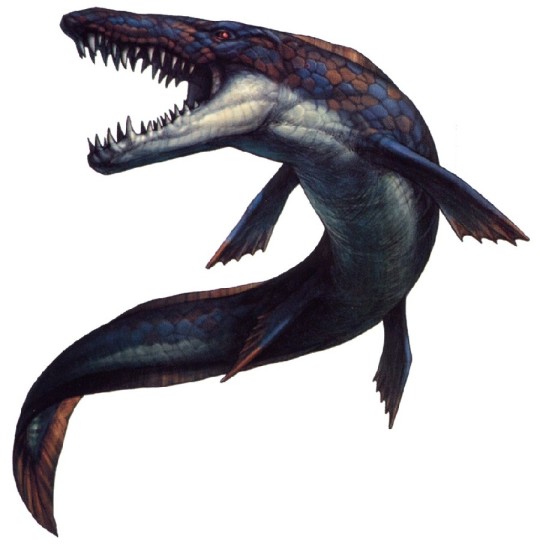
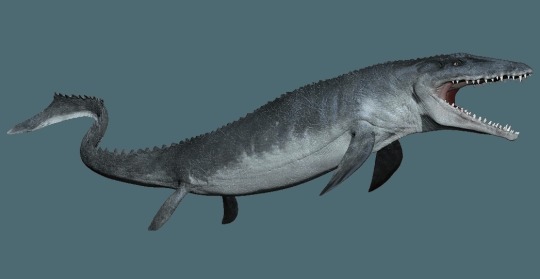
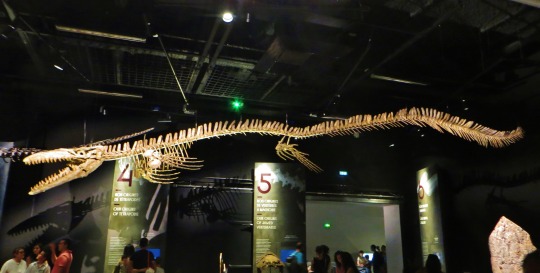
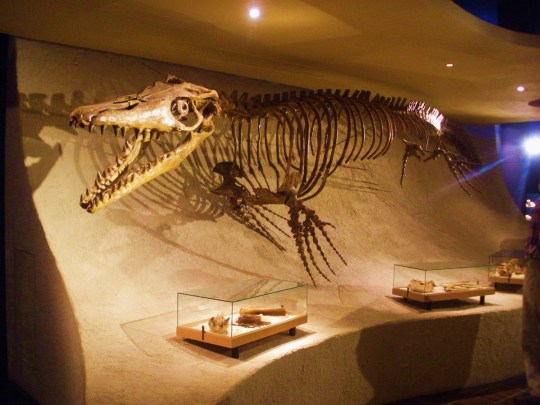
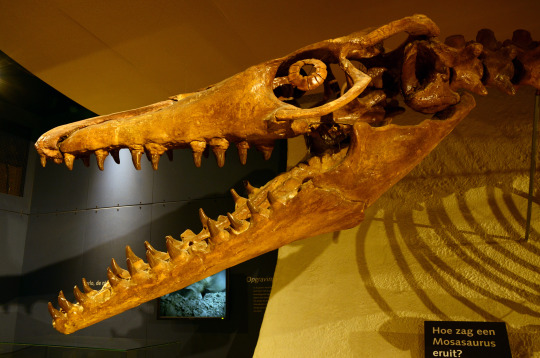
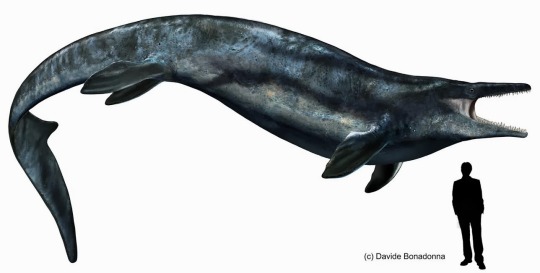

Mosasaurus
(temporal range: 82.7-66.0 mio. years ago)
[text from the Wikipedia article, see also link above]
Mosasaurus (/ˌmoʊzəˈsɔːrəs/; "lizard of the Meuse River") is the type genus (defining example) of the mosasaurs, an extinct group of aquatic squamate reptiles. It lived from about 82 to 66 million years ago during the Campanian and Maastrichtian stages of the Late Cretaceous. The genus was one of the first Mesozoic marine reptiles known to science—the first fossils of Mosasaurus were found as skulls in a chalk quarry near the Dutch city of Maastricht in the late 18th century, and were initially thought to be the bones of crocodiles or whales. One skull discovered around 1780, which was seized by France during the French Revolutionary Wars for its scientific value, was famously nicknamed the "great animal of Maastricht". In 1808, naturalist Georges Cuvier concluded that it belonged to a giant marine lizard with similarities to monitor lizards but otherwise unlike any known living animal. This concept was revolutionary at the time and helped support the then-developing ideas of extinction. Cuvier did not designate a scientific name for the new animal, and this was done by William Daniel Conybeare in 1822 when he named it Mosasaurus in reference to its origin in fossil deposits near the Meuse River. The exact affinities of Mosasaurus as a squamate remain controversial, and scientists continue to debate whether its closest living relatives are monitor lizards or snakes.
Traditional interpretations have estimated the maximum length of the largest species, M. hoffmannii, to be up to 17.1 meters (56 ft), making it one of the largest mosasaurs, although some scientists consider this an overestimation with recent estimates suggesting a length closer to 13 meters (43 ft). The skull of Mosasaurus was equipped with robust jaws capable of swinging back and forth and strong muscles capable of powerful bites using dozens of large teeth adapted for cutting prey. Its four limbs were shaped into robust paddles to steer the animal underwater. Its tail was long and ended in a downward bend and a paddle-like fluke. Mosasaurus was a predator possessing excellent vision to compensate for its poor sense of smell, and a high metabolic rate suggesting it was endothermic ("warm-blooded"), an adaptation in squamates only found in mosasaurs. There is considerable morphological variability across the currently-recognized species in Mosasaurus—from the robustly-built M. hoffmannii to the slender and serpentine M. lemonnieri—but an unclear diagnosis (description of distinguishing features) of the type species M. hoffmannii led to a historically problematic classification. As a result, more than fifty different species have been attributed to the genus in the past. A redescription of the type specimen in 2017 helped resolve the taxonomy issue and confirmed at least five species to be within the genus. Another five species still nominally classified within Mosasaurus are planned to be reassessed in a future study.
Fossil evidence suggests Mosasaurus inhabited much of the Atlantic Ocean and the seaways adjacent to it. Mosasaurus fossils have been found in places as diverse as North and South America, Europe, Africa, Western Asia, and Antarctica. This distribution encompassed a wide range of oceanic climates including tropical, subtropical, temperate, and subpolar climates. Mosasaurus was a common large predator in these oceans and was positioned at the top of the food chain. Paleontologists believe its diet would have included virtually any animal; it likely preyed on bony fish, sharks, cephalopods, birds, and other marine reptiles including sea turtles and other mosasaurs. It likely preferred to hunt in open water near the surface. From an ecological standpoint, Mosasaurus probably had a profound impact on the structuring of marine ecosystems; its arrival in some locations such as the Western Interior Seaway in North America coincides with a complete turnover of faunal assemblages and diversity. Mosasaurus faced competition with other large predatory mosasaurs such as Prognathodon and Tylosaurus—which were known to feed on similar prey—though they were able to coexist in the same ecosystems through niche partitioning. There were still conflicts among them, as an instance of Tylosaurus attacking a Mosasaurus has been documented. Several fossils document deliberate attacks on Mosasaurus individuals by members of the same species. In fighting likely took place in the form of snout grappling, similarly seen in modern crocodiles today.
6 notes
·
View notes
Text
Secrets of England: Unveiling Hidden Treasures beyond the Crowds
There are untold astounding places to explore in England, including enormous national parks, stunning beaches, cultural cities, & majestic castles. Residents of England are constantly on the lookout for novel places to see as staycations grow in fame. We would want to show you a new England. Here is our analysis of the off-the beaten England sightseeing places.
Off-the-Beat Attractions in England
Here are some must-see England tourist attractions that are off-the-beaten.
The Jurassic Coast

This is a UNESCO World Heritage Site that is home to spectacular coastal scenery, fossils, and unusual geological formations. It is situated on the southern coast of England.
Lundy Island
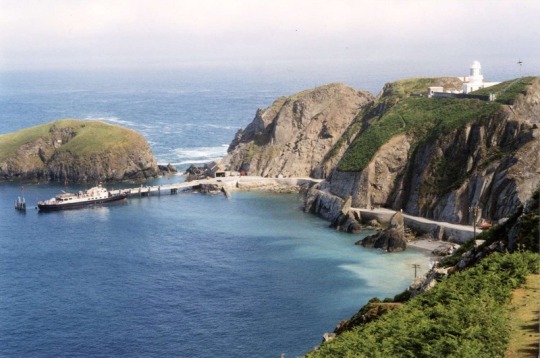
Image credit- johngrimes.co.uk
A shelter for wildlife, such as puffins and seals, Lundy Island is located in the Bristol Channel. It is a tranquil getaway that is far away.
Avebury

Frequently overshadowed via Stonehenge, Avebury has a larger and no less enigmatic stone circle. Even walking amid the stones is possible.
The Lost Gardens of Heligan
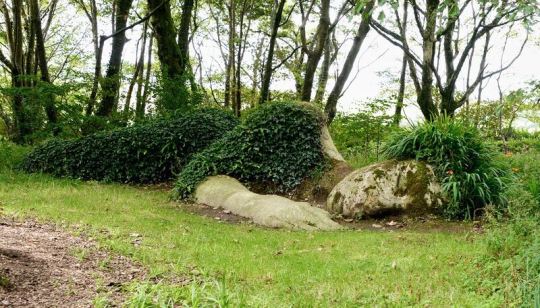
These gardens, which are in Cornwall, were long forgotten about before being found and brought back to their former splendor.
Stourhead
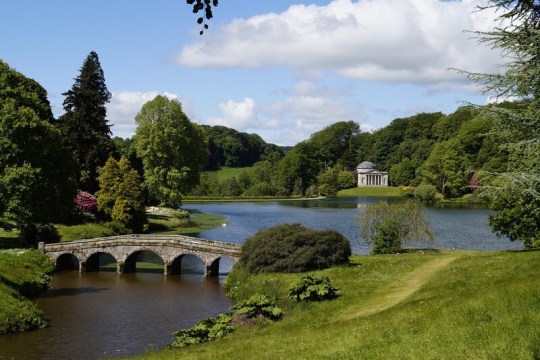
With its traditional temples, bridges, and grottoes, this Wiltshire manicured park from the 18th century is a beautiful site to explore.
Durham Cathedral
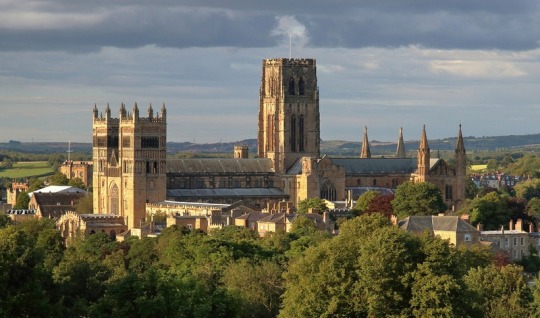
The UNESCO World Heritage Site Durham Cathedral and the ancient Durham Castle are located in this northeastern English city.
The Norman Gate

Many people frequently overlook the Norman Gate, in Windsor Castle which is located at Lower Ward entrance. It is an amazing piece of architecture & was built into the castle's original medieval framework.
Rievaulx Abbey
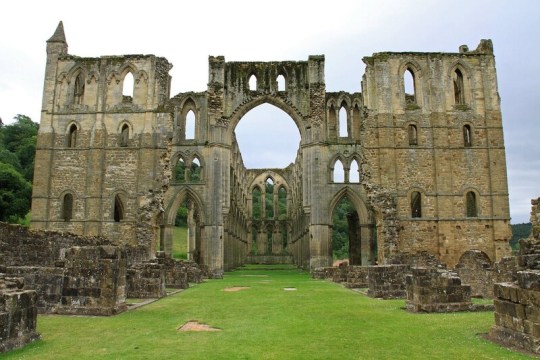
This Cistercian abbey is a gorgeous and tranquil location tucked away in North York Moors.
The Seven Sisters

Such impressive white chalk cliffs in Sussex offer wonderful hiking opportunities and expansive vistas of the English Channel.
The Cotswolds
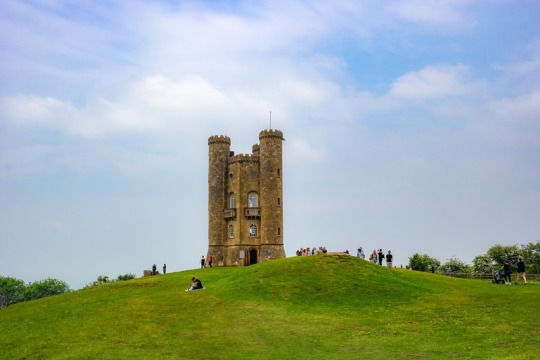
Although not completely off the beaten track, smaller towns like Bibury & Castle Combe provide a more tranquil and conventional English rural experience.
Museum of Bath
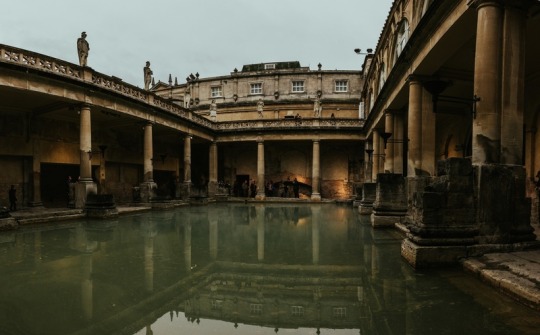
Housed in a historic structure, this museum provides an overview of Bath's architectural heritage and is frequently less crowded than the city's top tourist destinations. There are several interesting things to do near bath for instance Oxford.
Aysgarth Falls Yorkshire

This group of waterfalls in Yorkshire Dales is a tranquil and lovely place to hike.
Dungeness
A shingle beach, vintage fishing boats, & an abandoned nuclear power plant are some of the peculiar and unsettling elements of this Kent coast location.
The Tamar Valley
With its trees, meadows, and Tamar River, this region on the boundary between Devon & Cornwall is a hidden jewel of natural beauty.
The York Art Gallery is home to a remarkable collection of artworks, including pieces by well-known painters like Lowry & Hockney, despite not being as well-known as some other art institutions in the UK. This is amid the best things to do in York.
Why England’s Off-the-Beat Path Attractions so Popular?
For a variety of interesting sounding reasons, off-the-beaten-path tourism in England has grown in popularity as tourists look for authentic and one-of-a-kind experiences. Here are some strong arguments for why these hidden best places to visit in England so alluring.
Hidden treasures and lesser-known locations in England provide a change from the typical tourist crowds. Exploring these uncharted territories can be an exciting journey. Visitors can fully immerse themselves in the customs, traditions, & way of life of the area by venturing off the beaten path. These less-traveled areas offer genuine encounters that let visitors see England as it really is, unfiltered by tourism.
Destinations that are off the usual route can have breathtaking natural beauty, from tranquil farmland views to rocky coasts. England is rife with history, and undiscovered places can include historical gems that may not be as well-known or popular.
These isolated spots give a respite from the bustle of more popular tourist destinations and offer a sense of peace & tranquility that is difficult to obtain elsewhere. A sense of excitement and discovery are sparked by exploring off-the-beaten-path locations, making the journey itself an unforgettable aspect of the vacation experience.
Wrapping Up As you find areas that not everyone gets the chance to view, discovering secret famous places in England and following the path less taken can give you a sense of success.
3 notes
·
View notes
Photo
looking at and imagining opabinia, anomalocaris and trilobites, with the last you often don't even have to imagine! because those fucking guys were SO incredibly abundant that even though they existed over 250 million years ago, their existence span being about 300 million years made them so available in the fossil record, that we know of at least 20,000 species of those guys! it also makes it entirely realistic for someone to find some fossils of them on their own, which I have had the incredible chance to do so once, and it is likely that you could too! recommended to find some sites with higher erosion rate through some local ecology websites and forums, but it is definitely something that one might do just like, randomly, on their own, just go to a creek and crack some rocks
the second top experience after discovering a trilobite is me holding and looking around at flint (silica) deposits of (at that point unknown to me) creatures, but the sheer realisation of holding something that was alive, encased in chalk rock, when the absolute MOUNTAIN I'm standing on was still under water? literally mind blowing, I couldn't stop thinking about it for a couple months after that experience at the age of around 11 and I fear I may never recover the epiphany I've gained back then.
However. if we're talking about alive critters, if you do know (which let's be honest you probably do it's Tumblr after all) about the way anglerfish reproduce I'd encourage you to research it (short form descriptiom: males only exist to latch onto the female and fuse with it forever, only their prostate being left connected to the female, who uses it whenever needed, many such males can be attached to each female, causing it to have "lumps" which used to be the males)
Also lesbian lizards that are entirely capable of reproducing by themselves but still choose to live in couples, and have "sesbian lex" which uhhh.... more of a ritual? it's shown that it still motivates them to reproduce... but doesn't mix their code and is just them interacting ig, btw they only evolve when they OCCASIONALLY choose to reproduce with the males of their subspecies or closely related species, since all of them are female.
TLDR: I found a trilobite, held a flint deposit of a critter, also angler fish reproduction and lesbian lizards are fucking awesome

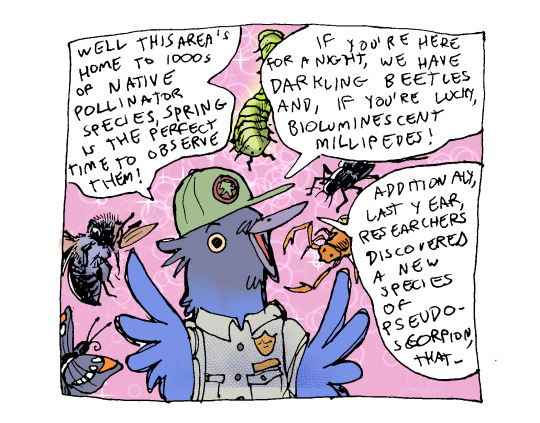
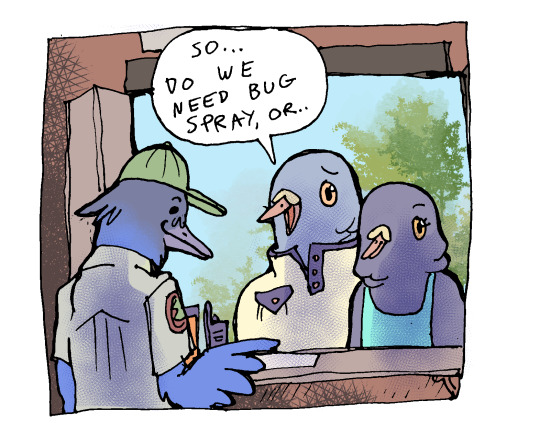
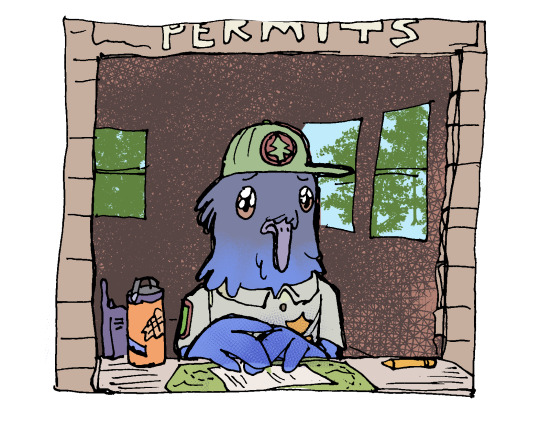
Support your local park rangers
#isoposting#real isopod hours#bugblr#isopods#ridiculous creature#bugs#isopod#love the unloved#autism#fucking love lizards#trilobites#paleontology#lesbian lizards#parthenogenesis#fucking love sesbian lex lizards
95K notes
·
View notes
Text
66 million-year-old fish vomit discovered in Denmark
As part of our continuing coverage of fossilized vomit, here's a BBC report:
A piece of fossilised vomit dating back to the time of the dinosaurs has been discovered in Denmark.
…
Jesper Milan, palaeontologist and curator at the museum, told the BBC it was "truly an unusual find" as it helps explain relationships in the prehistoric food chain.
"It tells us something about who was eating who 66 million years ago," he said.
During the period fish and sharks would eat sea lilies, which are hard to digest meaning they would then "regurgitate all the chalk bits", he explained.
Dang, taking sea lilies off the list of things I want to munch on. Well, maybe just one...
0 notes
Text
The Journey of Calcium Carbonate in Nature
Calcium carbonate is a naturally occurring compound that plays a significant role in various geological and biological processes. From the formation of limestone to its presence in shells and coral reefs, the journey of calcium carbonate in nature is both fascinating and essential to many ecosystems. Let’s explore how calcium carbonate moves through the environment and its important uses in the world around us.

Formation of Calcium Carbonate
Calcium carbonate begins its journey deep within the Earth. It is formed through both biological and geological processes. In geology, it can crystallize from water that has high concentrations of calcium ions and carbonate ions. Over time, these minerals precipitate to form rock structures such as limestone, marble, and chalk. These rocks are made up primarily of calcium carbonate and are commonly found in regions with a history of marine environments.
On the biological side, many organisms, such as mollusks, corals, and some algae, produce calcium carbonate to build their shells or skeletons. This process, known as biomineralization, involves the extraction of calcium and carbonate from seawater to form calcium carbonate, which hardens into shells or exoskeletons. These creatures play an essential role in the carbon cycle, helping regulate the amount of carbon dioxide in the atmosphere.
The Role of Calcium Carbonate in Ecosystems
Calcium carbonate’s role in ecosystems is vital, especially in marine environments. Coral reefs, for instance, are composed largely of calcium carbonate structures produced by coral organisms. These reefs support a vast array of marine life by providing habitats for fish, invertebrates, and other marine organisms. The calcium carbonate skeletons of corals also help in absorbing carbon dioxide from the water, which impacts the overall health of the ocean ecosystem.
On land, calcium carbonate can be found in soils, where it affects the pH level. It acts as a natural buffer, helping to neutralize acidic soils and promoting healthier plant growth. The presence of calcium carbonate in soil is also crucial for supporting agriculture, as it improves soil quality and promotes the growth of crops.
Human Uses of Calcium Carbonate
While calcium carbonate naturally cycles through ecosystems, humans have also discovered many uses for it. The compound is commonly used in the production of cement, a material vital for construction. Calcium carbonate is a key ingredient in making lime, which is used to purify water and treat industrial waste. Additionally, the mineral is widely used in the manufacturing of paper, paints, plastics, and even as a dietary supplement in the form of calcium pills for bone health.
In the world of calcium, some studios utilize calcium carbonate powder in certain materials for 3D modeling and digital effects. It is essential for creating materials that mimic real-world textures, providing artists with tools to enhance their creative work.
The Impact of Calcium Carbonate on Climate Change
Calcium carbonate plays a crucial role in the global carbon cycle. The process of carbonation, where carbon dioxide reacts with calcium minerals, helps sequester carbon in the Earth's crust, preventing it from entering the atmosphere. Over millions of years, this process has helped regulate the Earth's climate by reducing the concentration of carbon dioxide in the atmosphere.
However, human activities, such as the burning of fossil fuels, are increasing the levels of carbon dioxide in the atmosphere. This leads to higher amounts of carbonic acid in the ocean, which in turn affects marine organisms that rely on calcium carbonate for their shells and skeletons. As the oceans become more acidic, the ability of these organisms to form calcium carbonate structures diminishes, threatening the delicate balance of marine ecosystems.
Learning and Exploring the World of Calcium
Understanding the journey of calcium carbonate in nature is just one example of how scientific knowledge can be used creatively. For those interested in exploring how natural processes and materials can be represented in digital art, pursuing offers an opportunity to learn the skills needed to bring such concepts to life. Provide students with the tools to create visual stories and simulations that explore a wide range of scientific and environmental topics.
By combining artistic expression with scientific understanding, animators can create visual narratives that educate and inspire others about the natural world, including the fascinating journey of calcium carbonate.
0 notes
Text
Best 21 National Parks in Egypt
Best 21 National Parks in Egypt
1- The National Park of Ras Muhammad

One of national parks in Egypt is The National Park of Ras Muhammad is definitely one of the most captivating sites in Egypt and the world, which was announced a protected area in 1983. It is located at the southern tip of the Sinai Peninsula, overlooking the beautiful Gulf of Aqaba and Suez. The area is 133 square miles (345 square kilometers) filled with all kinds of marine life. It is an ideal place for an enchantingly diverse ecosystem of beaches, coral reefs and more.
The average temperature in the national park is around 23°C (73°F). Located at the tip of the Sinai Peninsula, the park’s mangrove forest is known as a stunning feature. The region also contains beautiful valleys and mountains, gravel plains, coastal mudflats, and sand dunes.
The national parks in Egypt are filled with thousands of different species of fish: 40 species of starfish, 150 species of crustaceans, 220 different species of coral, and 25 species of sea urchins. The park is famous for the presence of the green turtle and the hawksbill turtle. This is the main reason why it is an ideal place to enjoy diving and snorkeling trips. You will find it about 20 km from Sharm El Sheikh, and only 446 km from Cairo. The national parks in Egypt are an ideal place for all types of divers, hikers and swimmers.
2- Wadi El-Hitan National Park

Wadi El-Hitan National Parks in Egypt are not just a gorgeous park, but it is actually one of the most famous national parks in Egypt, and to be more specific, “one of the top 5 national parks in Egypt” in the country and named after it contains fossils of prehistoric whales in its area. Showcasing its evolution over time, these fossils have made this national park famous. It was announced a UNESCO World Heritage Site in 2005. It is located in Giza and is ready to receive visitors throughout the week from 07:00 until 17:30.
The park has an area of 7,450 square kilometers and contains rich ecosystems consisting of 4,770 square kilometers of land and 2,100 square kilometers of marine land filled with numerous deserts, mountains, valleys and coastal landscapes. Its biodiversity shines with a variety of plants and animals, including 450 species of coral, more than 1,200 species of fish and reptiles, and 13 different species of birds and mammals. Dorcas gazelle and Nubian ibex consider this area their exclusive home. The park has great historical and archaeological value, as it includes ancient ruins dating back to the Ptolemaic and Roman eras, in addition to prehistoric rock arts, all of which prove human presence and activities extending back thousands of years.

A unique area with cultural significance, known for its natural springs and date palms, surrounded by the Great Sand Sea. White Desert National Park Famous for its otherworldly chalk rock formations and desert landscapes, it’s a popular destination for camping and exploration. Gebel Elba National Park Located in the southeastern Red Sea, it boasts rich biodiversity, including unique flora and fauna. Nile River Protected Areas Various areas along the Nile are protected to preserve the unique ecosystems and wildlife that thrive along the river. Zaranik Protected Area A coastal wetland that attracts numerous migratory birds, making it a haven for birdwatchers. Lake Qarun Protected Area This area includes a large saltwater lake and is known for its birdlife, especially flamingos. Kushite Valley An area rich in archaeological sites, it also serves as a natural habitat for several species. Taba Protected Area Located near the Israeli border, it features stunning marine environments and coral reefs. Mount Sinai Protected Area Famous for its religious significance, this area also offers hiking trails and unique mountain landscapes. Sahara el Beyda (White Desert) Known for its stunning white limestone formations and desert scenery, ideal for exploration. Pharaohs Island A small island with historical significance and beautiful marine environments, great for snorkeling. Elba National Park This area is known for its mountainous terrain and biodiversity, including unique species of plants and animals. Farafra Oasis A secluded oasis with beautiful landscapes and cultural heritage, surrounded by desert. Wadi Degla Protectorate A geological wonder near Cairo, known for its unique rock formations and hiking opportunities. Saluga and Ghazal Protected Area Located on the Nile, this area is vital for its wetlands and biodiversity. Ashtoum El Gamil Protected Area Known for its unique ecosystem, including mangroves and marine life. Wadi Rayan Protected Area A beautiful area with waterfalls, lakes, and diverse wildlife, perfect for eco-tourism. Suez Canal Protected Area This area plays a crucial role in preserving the unique ecosystems along the Suez Canal. Cairo Desert Protected Area A desert area that offers a glimpse into the natural landscape surrounding the bustling city of Cairo.
Reach out to us:
Emails
WhatsApp: 015 53119249
#egypt#egypttravel#traveler#travel2024#egyptattractions#visitegypt#trending#explorepage#vacation#tour#egyptatours#alexa#stanley#spendingtimewithfamily#followersreels#followforfollowback#wadielhitan#TheNationalPark#RasMuhammad#travel#egyptian#aswan#egypte#ancientegypt#cairoegypt#travelegypt
0 notes
Text
//forgot to post the next chapter last night. Here you go :)
A/N: I do not own the characters, concepts, and so on, this is my first try so please play nice kids. Enjoy.
Sunday was a pretty uneventful day as the four teens were physically dragging trough the day because of the lack of sleep, trying to study for the quiz that their teacher was preparing for them. Even Dr. O was having a hard time concentrating on writing the quiz as his attention was very clearly divided between his work, his dream, and the clear fatigue that has been with him since he heard 'the voice' and began working on the main computer in his basement/command center.
As the day wore on it became clear to Dr. O that there was no disturbance in the morphing grid nor anywhere else, so with the information that was generated from the computer he let out a sigh of relief and chalked up the dream and unshakeable feeling like a large battle was coming to just working too hard at school and being a ranger teammate/mentor to his students. Having felt at ease Dr. O finished up on the quiz he was going to give to his class tomorrow and decided to go to bed early, meanwhile his four ranger teammates where busy cramming worried about the impending quiz thanks to Kira's playful mood with Dr. O as she helped him out the previous day.
(Monday Morning, Reefside High)
As the students of Reefside high where in class chatting away unknowingly that their teacher was about to surprise them with a quiz, while the four rangers furiously flipped through pages of their science book for the quiz,
"Ok everyone lets take our seats, we're going to start out this week with a pop quiz." Dr. O announced as the whole class let out an anxious groan,
"So lets clear off the desks and get started." Dr. O commanded,
As the students complied Dr. O started to hand out the quizzes, Conner was clearly struggling to get through the quiz but Ethan, Trent, and Kira were getting though a little bit better than Conner was. Ten minuets later Dr. O called for the quiz, as he picked up the last stack of quizzes he began his lecture.
"Ok, who can tell me when the Triassic period started?"
The rest of the class went routinely enough until the bell rang signaling the end of class,
"Ok class that enough for today but don't forget to read chapter 9 and answer the questions on page 91 for next class." Dr. O said as the students gathered up their things to leave. The rest of the day went pretty uneventful until after school,
"Dr. Oliver, I need to have a word with you." Said principal Randall,
"Uh, sure what on your mind principal Randall?" came Dr. O's replied as he stopped gathering up his things to call it a day.
"I've heard that you have quite the collection of artifacts, could I see them?" Randall asked with a hopeful tone to her voice,
"Um, I don't know-"Dr. O started,
"Please Dr. Oliver, I would love to know what you have hidden away in your private collection." She said,
"Well, ok you can follow me to my house." Dr. O finally said giving in to his boss' request,
"Great I cant wait" she said with a mischievous grin on her face as they walked out of the room and turned the corner, at the moment they turned the corner the woman from the gym had turned the opposite corner looking very nervous about meeting Dr. Oliver. When she reached the science lab and tried to turn the handle, she couldn't because it was locked, she then look around though the window in the door and noticed that it was empty meaning that she had just missed him.
"Damm it, looks like I just missed him I'll have to try his house." She said out loud.
(Dr. Oliver's residence, outskirts of Reefside)
"And this piece I found on my doctoral internship with Anton Mercer." Dr. O said as he held up a little rock with a tiny fossilized fish in it,
"What's in here?" Randall asked as she lifted the lid of a miniature Ark of the Convent to reveal the thought lost Dragon Power Coin,
"Don't lift it." Dr. O said as he slammed the lid back down on the box,
"Whoa, what did I do?" she asked backing away with her hands up,
"Nothing it's just some of these artifacts are sensitive to the air." Dr. O said as a cover as to why he had freaked out when Randall opened the box that contained his old power coin.
"Oh sorry, I didn't know." Randall apologized,
"Its ok, you couldn't have known." He said, when all of a sudden he noticed a Tyrano-drone lurking outside though the window,
"Oh my god" Dr. O said as he tried to sound surprised,
"What? What's wrong?" she asked as she noticed the worried expression on Dr. O's face,
"Its those things that have been attacking the city." Dr. O explained,
"We got to get away." Randall said worried,
"Yeah I'll hold them off while you get to safety." He said as his strength returned,
"Are you going to be ok?" she asked,
"Yeah when I was younger I use to compete in marshal arts competitions all the time, it's like riding a bike." He said,
"Even so, you're not a young teenager anymore." Randall said, he then looked at her with a look of anger and thought,
"Why is my age such a big deal to everyone, I mean I'm not that old."
"Now go." He said as he ran out the door to take out the Tyrano-drones in his front yard, but there was a lot more there then he had though. He thought about morphing but decided he couldn't risk Randall finding out about his 'extracurricular activities' so he had no choice but fight them with out his powers. For every one drone he took town two more would take its place, it was becoming too much for him as the large group was beginning to surround him. Then he saw something that reassured him that it was not as bad as it looked, a white and black streak ran through the drones and cased sparks to fly as it ran by them, when the streak was no longer visible the white dino-thunder ranger was visible kneeling down with the phased Tyrano-drones behind him as the drones slowly fell down around Dr. O,
"Wow, that was amazing thank you helping me White Ranger." Dr. O said as he quickly approached the ranger to make sure he wouldn't spill the beans on their secret,
"What are you talking about-" Trent asked,
"Principal Randall was here when they attacked and I don't know if she is still here." Dr. O explained in a hushed volume so only Trent could hear,
"What are you talking about, no one is here besides you, me, and the scraps of the drones." Trent responded,
"Oh, then she must have gotten to safety then." Dr. O said,
"POWER DOWN!" Trent called out to demorph just as a pink Pontiac Firebird drove up and the one person that Dr. Oliver never expected to see got out of the car.
(Conner's car)
Conner sat in his car on his way home from a long day at school, but he couldn't shake the image of Kira laying lifeless in a dark room with a blue tube in front of her. It was a feeling of helplessness, like something big was about to go down and there was nothing that anyone could do to stop it; like the events in his dream was inevitable. When he got home he got out of his car and went inside and went straight for his room to continue his line of thought until, he stepped on a small bag of half eaten cheetos. As he sat down at his desk with his backpack and got out his math book to start on his homework when he looked up and saw a picture of him and the others on the team, he himself was behind Kira hugging her waist as they both smiled with a warm glow. At that he felt something inside of him grow,
"I have to make sure that dream never comes to pass, I need to fight harder to make sure that no one on this team get hurt; even if it means that I have to make the ultimate sacrifice." Conner said sounding like a true blue red ranger, but deep down inside he had to admit to himself that he was crazy for Kira.
(Kira's room)
Kira was working to keep her concentration on her book report for her English class, when she suddenly stopped and threw her pencil down on the paper and leaned back in her chair to try and clear her head. The dream she had about Conner dieing at the hands of some freaky monkey was too much for her to bear, she was going crazy trying to figure out what her dream meant but then she had an idea of who to ask,
"Hey mom, I'm going to Hayley's for a while" Kira called out to her mother,
"Ok honey just be back in time for dinner, its taco night." Mrs. Ford replied,
Kira needed to talk to someone knowledgeable to get their take on her dream, and make sure she wasn't losing it.
(Mysterious Island Lair)
Elsa returned to the lab on the hidden fortress through an invisa-portal with a rather triumphant grin on her face,
"What are you so happy about?" asked Zeltrax with a clearly jealous tone in his voice,
"Well I so happy because I got the power source that we need for the plan." Elsa replied very smugly as she held up the Dragon Power Coin!
"Elsa, good work recovering the power source needed to power the weapon of the rangers final destruction." Mesogog hissed in approval,
"Thank you my lord, just allow me to make the following changes to the machine to allow it to draw power from the power coin." Elsa replied,
"How long do you need Elsa?" Mesogog asked,
"It should be ready by this time tomorrow." Elsa replied with a look of fear that her answer would set off her master,
"Please proceed, Elsa and alert me when you are done. Oh and Zeltrax help Elsa with anything she may need." Mesogog commanded as his henchmen scurried of to their respective tasks.
(Outside Dr. O's house)
"Hey Tommy, I guess you just cant leave this behind huh?" asked the woman,
"Dr. O, you ok? Who is she?" asked Trent trying to snap his mentor out of his haze,
"Yeah . . . I guess I cant. Trent this is Kimberly Hart the first Pink Ranger and my First Love." Dr. O replied as he fainted.
6 notes
·
View notes
Photo

Xiphactinus was a huge, predatory fish that lived during the Late Cretaceous. It would have been a veracious predator, growing 15-20 feet long. When alive, the fish would have resembled a gargantuan, fanged tarpon. Fossils of this monster fish can be found in the Smoky Hills Chalk of Kansas. This is a spectacular 10" long, fossil jaw that just arrived and is now posted for sale on FossilEra. Just check out those fangs!
9.7" Monster Fish (Xiphactinus) Jaw - Terror Of The Cretaceous Seas!
55 notes
·
View notes
Text
A Voyage Through the Isles of Rust - made with Alone Among The Stars
The first isle - ♦5 ♦4 a town carved into the sides of a narrow fjord. inland, a coniferous forest. lights among the trees.
The second isle - ♥K ♥Q ♣4 an empty place, ruined by magic, half submerged beneath the waves and half suspended in the air above. sometimes a fragment of stonemasonry will fall and crush an unlucky boat. rich fishing in the surrounding reefs, though few risk these waters.
The third isle - ♠10 ♥A ♣5 a cliff face of columnar basalt. a long-abandoned monastery. the apple orchard that once fed the acolytes is overgrown with mistletoe.
A port on the mainland - ♦2 ♦J ♣3 ♥9 a desert city, sustained by a river. Seeking to avoid the heat of the day, the people go about their business at moonrise and plant night-blooming gardens by the riverbank. there are rumors that the ruins of a far older city lie buried beneath.
The fourth isle - ♠7 ♦10 a volcanic island, inhabited only by the seabirds nesting on the cliffs.
The fifth isle - ♣A ♠K a small island, empty save for a grove of towering cedar trees. Mirages of ghost ships and castles in the air are often reported here.
The sixth isle - ♦6 ♠A ♠2 ♠8 ♣9 the chalk fossils of ancient sea creatures are found on this island, shining like ghosts in the moonlight. the people of the island live in small mountain villages, herding sheep in the valleys and farming mushrooms in great vaulted wine-cellars.
The seventh isle - ♦K ♠6 ♠9 ♠4 ♥10 ♣10 - the home of a dragon, who makes her lair in an abandoned rock-cut temple overgrown by blue-flowered convolvulus vines. She claims ownership of the rich veins of silver which run through every part of the island.
The eighth isle - ♠3 ships often stop at this uninhabited islet, where a freshwater spring feeds a scenic waterfall.
A port on the mainland - ♦3 a sleepy little fishing town on the shores of a tidal estuary,
The ninth isle - ♠Q ♥3 a warship wrecked on a sandbar in the river delta long ago, overgrown by trees and accumulating tidal sediment.
The tenth isle - ♥6 ♥2 ♦9 strange petroglyphs are visible on the mountainside under the light of the waning moon. bat colonies nest in the sea-caves.
3 notes
·
View notes
Text
the sides + animal crossing
virgil
absolutely hates fishing. he has to slam his eyes shut and nervously wait for the plop every single time, and if he misses a fish he will mentally berate himself for twenty minutes
TARANTULA. HUNTING. he is an absolute boss at catching them so he doesn’t really have trouble getting bells. definitely keeps one in his house as a pet.
he doesn’t like all of his villagers, but he’d feel bad ignoring them (bc he knows how it feels) so he talks to all of them anyway
made his real jacket in custom designs and never takes it off
roman
resident representative?? nah bro, he’s the prince of the people
loves to talk to the villagers bc it makes him feel like he’s checking on his faithful subjects
literally never pays his debt because he’s too broke after buying all of the furniture, wallpapers, and flooring he can get his hands on
once he unlocked terraforming, he went a little crazy with it and basically created a feudal state, complete with fields for the serfs (the villagers), a castle (his house) on the highest hill, and all the shops spread out on the second highest cliff
has over a thousand custom designs that he’s made and others that he’s just seen and thought they were cool, still only ever wears one of them
patton
likes taking a bunch of cute lil’ pictures with the nook phone’s camera app
completely loses it whenever the villagers sing or pretend to be airplanes bc they’re just!! so cute!!!
FLOWER GARDENS!!!
cries when villagers say “i just can’t seem to shake you today, what’s up?” after he talks to them twice because he doesn’t wanna be too clingy and oh no now they hate him and they’re gonna move and–
unholy screaming when he saw his first tarantula
logan
he is on a Quest to fill up his museum and is practically halfway there already
blathers is absolutely his fave with all those bug, fossil, and fish facts
probably the only one besides virgil who pays his debt off fairly quickly
made himself a little telescope area on the beach & almost cried when he found out shooting stars were a thing
very confused by tom nook’s business practices and how fruit seems to grow so quickly
remus
absolute menace. doesn’t listen to blathers’s facts and only brings him bugs just to see him panic
physically harasses his least favorite villagers with a net. also runs behind them with a metal axe, just because he can
he doesn’t pick any of the weeds on his island and instead digs up all of the flowers. everyone else is horrified when they all come to visit
he found out you could put patterns on the floor and recreated a crime scene outside his house with a fake chalk outline of a body
no one gives him best friend privileges on their islands because they are terrified of the chaos he will bring about
deceit
refuses to pay his crippling debt to tom nook in order to rebel against society
no one (except remus) visits his island bc he Will force them into slave labor like they’re his henchmen
breeds flowers until he gets the cool, dark black versions and then gets rid of every other color until there are only dark black flowers everywhere for the Aesthetic
as soon as he is able, he moves his house to the highest cliff in order to make himself a cool evil villain hideout area also for the Aesthetic
#this was super self-indulgent lol#deceit wears a bowler hat and capelet and some ppl really out here saying he DOESN’T love the evil villain aesthetic??#like he doesn’t have to be evil to appreciate the evil Look y’know??#sanders sides#thomas sanders#roman sanders#virgil sanders#patton sanders#logan sanders#remus sanders#deceit sanders#animal crossing#ts roman#ts virgil#ts patton#ts logan#ts remus#ts deceit#long post#my stuff
221 notes
·
View notes